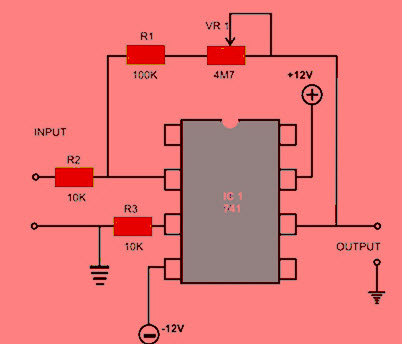Op Amp Circuit Types

Op amp circuit types
There are two types of op-amps: single power supply type and dual power supply type. In the case of a single-supply op-amp, VCC is positive with respect to GND. In the case of a dual-supply op-amp, VCC is positive and VEE is negative with respect to GND.
What are the 3 types of amplifiers?
Classification of the amplifier can be done in 3 different ways. Voltage amplifiers. Current amplifiers. Power amplifiers.
What is an opamp circuit?
An operational amplifier (op amp) is an analog circuit block that takes a differential voltage input and produces a single-ended voltage output. Op amps usually have three terminals: two high-impedance inputs and a low-impedance output port.
What are the 4 stages of op-amp?
There are four basic sections: bias, 2:1, gain and buffer (Figure 2). These four stages can be combined in some op amp devices, but the four functions are fundamental. The bias section provides all of the voltages and currents needed by the other 3 sections.
What are the 3 op-amp rules?
Here are the golden rules of operational amplifiers:
- 1) Infinite Open Loop Gain.
- 2) No current flowing through both of the Inputs.
- 3) Potential Difference between input pins is ZERO.
What is Opamp used for?
In the most basic circuit, op-amps are used as voltage amplifiers, which can be broadly divided into noninverting and inverting amplifiers. Voltage followers (also simply called buffers) are a type of commonly used noninverting amplifiers. Op-amps are also used as differential amplifiers, integrator circuits, etc.
What are the 5 classes of amplifier?
Power amplifier circuits (output stages) are classified as A, B, AB and C for linear designs—and class D and E for switching designs. The classes are based on the proportion of each input cycle (conduction angle) during which an amplifying device passes current.
What is a 3 stage amplifier?
In three stage amplifier the first stage consists of a differential amplifier,second stage consists of a coupling device as a combination of diodes and third stage uses a current limiter. The three stages are: First stage-Differential amplifier, Second stage-Combination of diodes, Third stage-Current limiter.
Where is op amp used in real life?
Op amps are used in a wide variety of applications in electronics. Some of the more common applications are: as a voltage follower, selective inversion circuit, a current-to-voltage converter, active rectifier, integrator, a whole wide variety of filters, and a voltage comparator.
Is op-amp DC or AC?
Op-amps use a DC supply voltage, typically anywhere from a few volts on up to 30 V or more. If the power supply is a perfect DC voltage source (that is, it gives the same voltage no matter what happens), the op-amp's output would be solely governed by its inputs.
Why Opamp is active device?
OPAMP (operational amplifier), BJT, JFET (transistors), it is called active devices, because of its ability to manipulate and maintain voltage or constant current (within specified operating ranges, unlike the ideal elements).
Why capacitor is used in op-amp?
A common op-amp circuit uses a feedback capacitor to limit the bandwidth. Limiting op-amp bandwidth will reduce noise, so a feedback capacitor is a common way to reduce noise. To understand how the feedback capacitor works, consider that a capacitor acts as a short to “high frequency” AC signals.
What is slew rate?
Slew rate is defined as the maximum rate of change of an op amps output voltage, and is given in units of volts per microsecond. Slew rate is measured by applying a large signal step, such as one volt, to the input of the op amp, and measuring the rate of change from 10% to 90% of the output signal's amplitude.
Which type of coupling is used in op-amp?
Operational amplifiers (op-amps) use internal capacitive coupling between stages.
What is gain factor?
The amplification factor, also called gain , is the extent to which an analog amplifier boosts the strength of a signal . Amplification factors are usually expressed in terms of power . The decibel (dB), a logarithmic unit, is the most common way of quantifying the gain of an amplifier.
What is the range of op-amp?
Most high speed op amps will source and sink between 50 - 100 mA, though a few are limited to less than 30 mA. Even for high speed op amps that have short circuit protection, junction temperatures may be exceeded (because of the high short circuit current) resulting in device damage for prolonged shorts.
What limits an op-amp?
Short Circuit Output Current In case of a practical Op-Amp, the internal source is not ideal since it cannot provide an infinite amount of load current. Hence, another non-ideal Op-Amp characteristic is that the maximum output current of the Op-Amp is limited by the short circuit output current (ISC).
What are op-amp limitations?
The maximum bias current of the Op-Amp is 100 nA. The maximum offset current is 40 nA, and the maximum offset voltage is 2 mV. One of the practical op amp limitations is that the input bias currents for the two inputs may be slightly different.
Is opamp active or passive?
An op-amp is an active device, requiring external power to produce high gain, unlike the simple passive elements (resistor, capacitor, and inductor) of Section 5.2.
Why Opamp is called 741?
IC 741 Op Amp (Operational Amplifier) It was first manufactured by Fairchild semiconductors in the year 1963. The number 741 indicates that this operational amplifier IC has 7 functional pins, 4 pins capable of taking input and 1 output pin.












Post a Comment for "Op Amp Circuit Types"